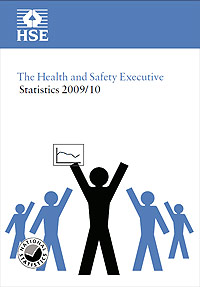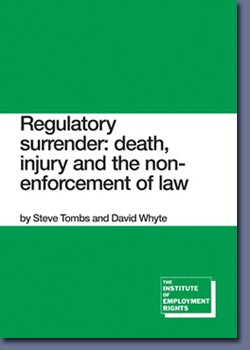HSE Official Stats Published For 2009
 Whilst the HSE have issued this month their offiical statistics into the health and safety of British industry, there are many who challenge these annual 'official' figures as being inaccurate and not a true reflection of workplace deaths and injuries.
Whilst the HSE have issued this month their offiical statistics into the health and safety of British industry, there are many who challenge these annual 'official' figures as being inaccurate and not a true reflection of workplace deaths and injuries.
Health and safety statistics 2009/10 issued by the HSE, provides the official " latest top level statistics on work-related ill health, workplace fatalities and injuries, and enforcement in Great Britain." according to the HSE website.
It was stated in the Hazards Magazine, July-Sept edition in publicising a report by Dr David Whyte and Professor Steve Tombs earlier this year that:
"Workplace safety standards have been undermined by the collapse of the Health and Safety Executive’s investigation and enforcement role. This ‘regulatory surrender’, warns a new report, means HSE is increasingly unaware of what’s going on at work and no longer has the resources to do much about it even if it did."
Nevertheless, the offical HSE published report gives some basic facts for 2009/10:
Key annual figures 2009/10
- 1.3 million people who worked during the last year were suffering from an illness (long standing as well as new cases) they believed was caused or made worse by their current or past work. 555 000 of these were new cases.
- 152 workers were killed at work, a rate of 0.5 per 100 000 workers.
- 121 430 other injuries to employees were reported under RIDDOR, a rate of 473 per 100 000 employees.
- 233 000 reportable injuries occurred, according to the Labour Force Survey, a rate of 840 per 100 000 workers.
- 28.5 million days were lost overall (1.2 days per worker), 23.4 million due to work-related ill health and 5.1 million due to workplace injury.
Fatal injuries to workers
■ There were 152 workers fatally injured in 2009/10 (provisional),
equivalent to a rate of 0.5 fatalities per 100 000 workers.
■ The inclusion of the 2009/10 data into the time series is fully
consistent with a continuing downward trend.
■ The rate for 2009/10 represents a statistically significant decrease
compared to the average rate for the previous five years.
■ Of the main industrial sectors, construction and agriculture have
the highest rates. These sectors accounted for 42 and 38 fatalities
respectively.
 Ealier this year, Dr Dave Whyte from the University of Liverpool and Professor Steve /tombs, John Moores Liverpool University published their report into the work of the HSE entitled 'Regulatory surrender: death, injury and the non-enforcement of law'
Ealier this year, Dr Dave Whyte from the University of Liverpool and Professor Steve /tombs, John Moores Liverpool University published their report into the work of the HSE entitled 'Regulatory surrender: death, injury and the non-enforcement of law'
Dr David Whyte explains: “The idea that health and safety has ‘gone mad’ does not seem to hold true. The collapse in inspection, investigation and enforcement has dramatically reduced the chances of businesses being detected and prosecuted for committing safety offences. Most serious injuries now are not even investigated. For example, only a third of amputations are now investigated by the Health and Safety Executive.”
This situation is reflected in the following trends over the past decade:
• a 69% fall in the numbers of inspections made of business premises;
• a 63% decline in investigations of safety incidents at work; and
• a 48% reduction in prosecutions
This collapse in inspection, investigation and enforcement has dramatically reduced the chances of businesses being detected and prosecuted for committing safety offences. This is hardly the deluge of red tape or the burden of regulation that permeates public debates about health and safety at work."
The full briefing is available from the E-Library Database and can be found by selecting 'Health and Safety Legislation' form the drop down list of categories on the search page here and selecting 'IER Briefing On Health And Safety Gone Mad'
Source: HSE / Unionsafety / Hazards



